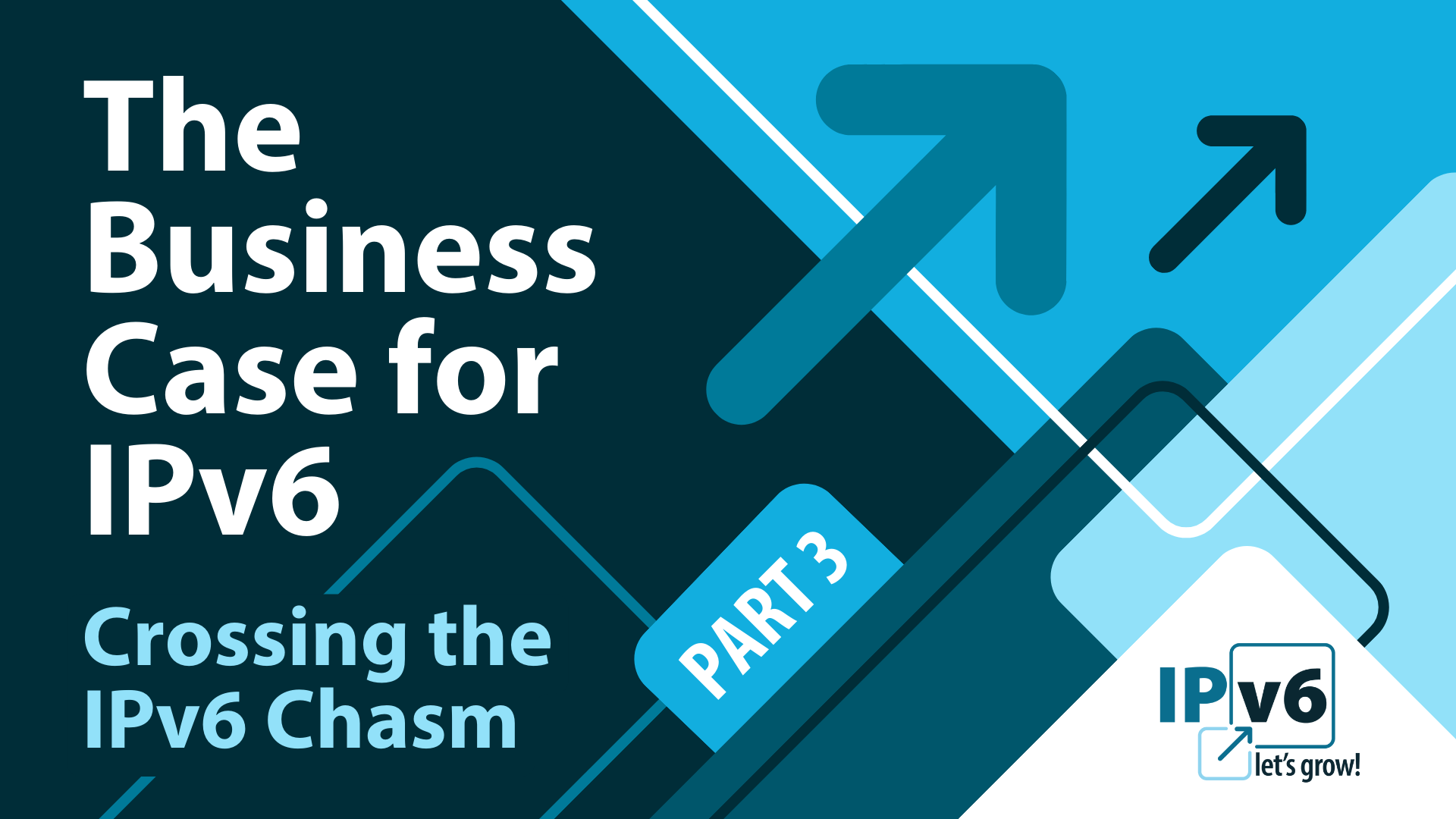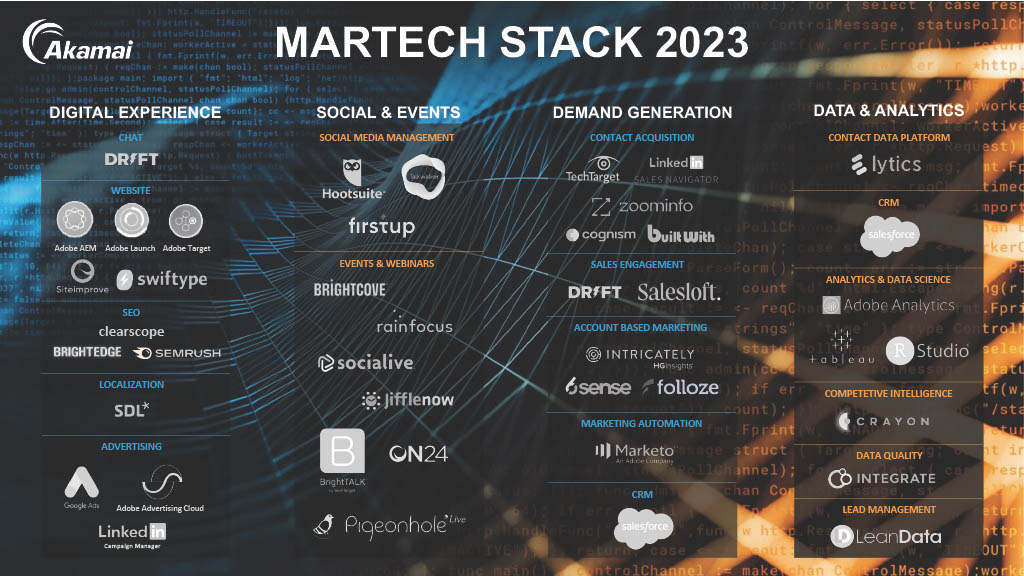
The Business Case for IPv6: Crossing the IPv6 Chasm
The maturity of a technology can be evaluated in multiple ways. Can it perform the task(s) it was designed to do? Can it integrate sufficiently with adjacent technologies? Is it manageable? IPv6 arguably has long proven itself as a mature technology by these measures. Deployment by many organizations over the past decade has demonstrated that IPv6 can be trusted to do its job at scale. Given these conditions, why the transition delay in enterprises? Multiple reasons and circumstances exist, but, in this blog post, I’ll focus on making the business case for enterprises — which don’t build or sell Internet products and services, but instead use the Internet as a critical enabler.
The Case for a Pivot
The message was clear for companies that build and sell Internet products and services: IPv6 transition was critical to their business models. The enterprise case is a more complex one to make. Chief Information Officers (CIOs) for enterprises in industries that leverage the Internet as a key, enabling technology but don’t necessarily build and sell Internet products and services are already struggling with tightening budgets and an endless list of competing priorities. Adding an IPv6 transition initiative when IP addressing isn’t visibly “broken” isn’t a project that’s likely to be prioritized or sponsored.
We’ve hit a chasm between the manufacturers of Internet products and services and the enterprises in most other industries, making it time to pivot our audience and our message for selling the business case for IPv6. “Crossing the Chasm” by Geoffrey A. Moore, a playbook for identifying and defining strategies for crossing the marketing chasm for technical products, provides a good jumping off point. While IPv6 is not a technical product per se, there are parallels we can leverage in order to move the IPv6 adoption needle.
Critical to building momentum for enterprises is translating IPv6 deployment from a strictly technology-based consideration governed by network infrastructure decision makers to a strategic business consideration in partnership with domains impacted by IPv4 scarcity. In the time of World IPv6 Day and Launch in 2011 and 2012, CIOs in the Internet service and product industries could initiate and secure sponsorship for IPv6 transition efforts on their own. For the enterprises we now need to convince, obtaining prioritization and sponsorship takes a corporate village.
Building that corporate village starts with communicating how an IP address delivers abstracted value: the functional areas to which it delivers value, how that value is delivered, and, most critically, the quantification of that value.
Decision Makers
The enterprise industries we need to motivate make decisions very differently than companies who offer Internet services and products as a core part of their product portfolios. There are more decision makers across multiple sectors to convince, from finance and retail to transportation, health care, manufacturing, etc. Despite the challenges of never-ending priorities and constrained budgets, IT has many opportunities for strengthening critical partnerships with decision makers who can be persuaded that there is sufficient value in the IPv6 transition to prioritize and sponsor the effort.
The entire C-suite is fair game, but I focus on Chief Marketing Officers (CMOs). Marketing is often an area with substantial budget, influential decision makers and potential sponsors, and an eagerness to evaluate incremental improvements to the return on investment of their very expensive digital campaigns. Marketing professionals tend to be tech-friendly and have existing close partnerships with IT.
Messaging
The IPv6 business case messaging of a more secure, accurate, and scalable Internet remains the same, but it needs slightly different packaging in order to motivate these enterprise decision makers to take action. Nothing will cause the eyes of a non-technical business decision maker to glaze over faster than a nuanced technical discussion. On the contrary, presenting an opportunity for improving key economic factors gets their attention. Ultimately, this discussion comes down to communicating the abstracted values IPv6 can incrementally improve. Gaining a deeper understanding of the abstracted value of an IP address through marketing applications can be the path to convincing a broader audience of decision makers and sponsors.
E-commerce Everywhere
E-commerce is a revenue generation channel leveraged by most industries. Two key performance indicators for e-commerce are the cart abandonment and cart conversion rates. Cart abandonment measures how often consumers initiate a purchase but abandon their carts before the purchase is completed. Cart conversion measures how many clicks progress successfully into a completed transaction, thereby converted into revenue. To have the IPv6 transition conversation with CMOs, we need to know:
- How page load times impact cart abandonment,
- How accurate geolocation impacts conversion rates, and
- How the abstracted value of IPv6, digested into marketing applications, can facilitate reduction of cart abandonment and increase in cart conversion.
Marketing teams invest an enormous amount to refine and measure their activities. And while IPv6 doesn’t directly generate revenue, it can be a facilitator. Two key characteristics of IPv6 are performance and more accurate geolocation, which can be leveraged for positive impact on revenue generation through reduced cart abandonment and increased cart conversion.
Consumers are addicted to speed. The faster technology goes, the faster we want it to go. According to Portent, page load time has a significant impact on cart abandonment, meaning page loads are a critical element of cart conversion.
Fragmented packets and NAT for IPv4 have been identified as potential contributors for performance degradation, as RIPE Specialist Erik Bais explains for Prefix Broker.
Geolocation
Conversion rates for e-commerce in the U.S. are low to begin with, and, according to Statista’s report for the second quarter of 2022, they continued to drop from 2.6% to 2.3% year-over-year. With such a low conversion rate as the “gold standard,” gains are measured incrementally. MaxMind’s GeoIP2 City Accuracy report for the U.S. indicates a 7% increase in correctly resolved geolocations when IPv4 addresses are excluded. This difference is significant, and the impact on revenue can be measured by marketing teams, which rely on accurate geolocation as a critical element of targeting their digital campaigns.
For example, I’m in Reno, Nevada, and frequently get geolocated to Seattle, Los Angeles, and Kansas. There are not many similarities between the demographic profiles of these locations, thus decreasing return on investment (ROI) for any campaigns dependent on this information. The features identified in Geo Targetly’s post “25 Simple Ways To Boost Website Conversion Rate Using Geo Targeting” are far less likely to be successful without IPv6.
IPv6 Influencing
Akamai has done us a favor by submitting their 2023 marketing technology (martech) stack for consideration for a Stackie award.
In it we can see the applications that ingest and measure the value of an IP address, and I’ve created an IPv6 inventory of Akamai’s martech applications:
| Application | IPv6 Support | URL | App Description |
|---|---|---|---|
| Drift | No | https://www.drift.com | Chat |
| Adobe AEM | Yes | https://experienceleague.adobe.com/docs/experience-manager-65/deploying/introduction/technical-requirements.html?lang=en | Website |
| Adobe Launch | Yes | https://business.adobe.com/products/experience-platform/launch.html | Tag management |
| Adobe Target | Yes | https://business.adobe.com/products/target/adobe-target.html | Testing, personalization, automation |
| Siteimprove | No | https://www.siteimprove.com/ | Web analytics |
| SwiftType | No | https://swiftype.com/ | Search |
| ClearScope | No | https://www.clearscope.io/ | SEO |
| BrightEdge | No | https://www.brightedge.com/ | SEO |
| Semrush | No | https://www.semrush.com/ | SEO |
| SDL* (RWS) | No | https://www.rws.com/ | Localization |
| Google Ads | Yes | https://ads.google.com/ | Advertising |
| Adobe Advertising Cloud | Yes | https://helpx.adobe.com/legal/product-descriptions/adobe-advertising-cloud.html | Advertising |
| LinkedIn Campaign Manager | Yes | https://business.linkedin.com/marketing-solutions/ | Advertising |
| Hootsuite | No | https://www.hootsuite.com/ | Social Media Management |
| Talkwalker | No | https://www.talkwalker.com/ | Consumer Intelligence |
| Firstup | No | https://firstup.io/ | |
| Brightcove | No | https://www.brightcove.com/ | Streaming |
| Rainfocus | No | https://rainfocus.com/ | Online Event Management |
| Socialive | No | https://socialive.us/ | Live streaming |
| Jifflenow | No | https://www.jifflenow.com/ | Meeting automation |
| Brighttalk | No | https://www.brighttalk.com/ | Webcast |
| On24 | No | https://www.on24.com/ | Virtual Conference |
| Pigeonhole | No | https://pigeonholelive.com/ | Interactive audience |
| TechTarget | No | https://www.techtarget.com/ | Targeted content management |
| LinkedIn Sales Navigator | Yes | https://business.linkedin.com/sales-solutions/ | Sales platform |
| Zoominfo | No | https://www.zoominfo.com/ | GTM Automation |
| Cognism | No | https://www.cognism.com/ | Lead generation |
| Builtwith | No | https://trends.builtwith.com/ | Web Usage Statistics |
| Salesloft | Yes | https://help.salesloft.com/ | Sales engagement |
| Intricately | No | https://www.intricately.com/ | GTM Intelligence |
| 6Sense | No | https://6sense.com/ | Account Based Marketing |
| Folloze | No | https://www.folloze.com | Account Based Marketing |
| Marketo | Yes | https://business.adobe.com/products/marketo/adobe-marketo.html | Marketing Automation |
| Salesforce CRM | Yes | https://www.salesforce.com/ | Customer Relationship Management |
| Lytics | No | https://www.lytics.com/ | Customer Data Platform |
| Adobe Analytics | Yes | https://business.adobe.com/products/analytics/adobe-analytics.html | Analytics |
| Tableau | Yes | https://www.tableau.com/ | Visual Analytics |
| RStudio | Yes | https://posit.co/ | Statistical programming language |
| Crayon | No | https://www.crayon.co/ | Competitive Intelligence |
| Integrate | No | https://www.integrate.com/ | Demand channels integration |
| LeanData | No | https://www.leandata.com/ | Lead Management |
Today’s results are discouraging. However, this provides a direct path to identifying opportunities for influencing marketers and their tech vendors. The good news is that marketing has begun buzzing about IPv6, as in this article from Ad Tech Explained.
The value of network effect of IPv6 on non-Internet industries can be an accelerator for the transition. We don’t need to boil the enterprise ocean. We can be successful by convincing just one enterprise influential in its sphere to take the lead. It will then adjust the many business levers at its disposal to convince its supply chains and customers to follow suit. Marketing is a natural fit for building momentum through network effect.
IPv6 Is Ready; Is Business?
Change is difficult, and change on the scale of the IPv6 transition is proving to be more challenging than many technical transitions we have successfully completed up to this point. Convincing the corporate village is critical, and it is dependent on reaching the strategic decision makers. Making incremental, yet strong, revenue arguments can go far in getting enterprise IPv6 transition over the hump of inertia.
We have the data to calculate the value IPv6 offers to enterprise financials and make the argument, but the challenges before us are:
- Increasing visibility in the greater C-suite audience, and
- Reliably quantifying the incremental improvement to revenue.
There will not be a single driver for IPv6 transition, and the argument for the non-Internet industries must be specific to enterprise business models. IPv6 has proven itself ready for business; let’s shift our targeted audience and messaging to get business ready for IPv6.
Any views, positions, statements, or opinions of a guest blog post are those of the author alone and do not represent those of ARIN. ARIN does not guarantee the accuracy, completeness, or validity of any claims or statements, nor shall ARIN be liable for any representations, omissions, or errors contained in a guest blog post.
Recent blogs categorized under: IPv6
GET THE LATEST!
Sign up to receive the latest news about ARIN and the most pressing issues facing the Internet community.
SIGN ME UP →Blog Categories
ARIN Bits • Tips • Updates • Elections • Caribbean • Outreach • Security • RPKI • Public Policy • Guest Post • Grant Program • Fellowship Program • Data Accuracy • IPv6 • Business Case for IPv6 • Internet Governance • Training • IPv4 • Customer Feedback • IRR




